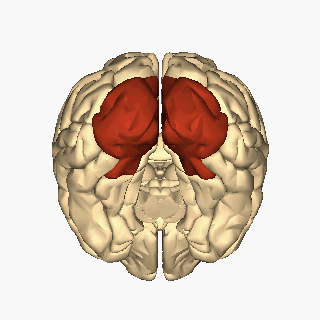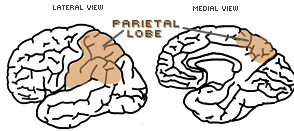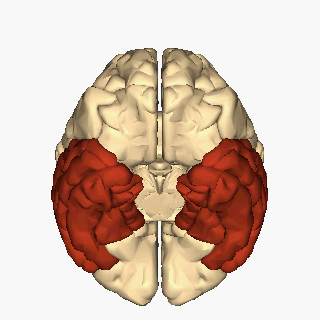Feb 1, 2025
![[Brain Image]](../graphics/head_space.gif)
PSY 340 Brain and Behavior
Class 11: Cerebral Cortex [Outline]
|
Feb 1, 2025 |
PSY 340 Brain and Behavior Class 11: Cerebral Cortex [Outline] |
|
Cerebral Cortex
![[Cerebral Cortex]](../graphics/cerebral_cortex2.jpg)
![[Gray & White Matter]](../graphics/gray_white_matter.jpg)
"gray matter" consists mostly of the bodies of neurons
"white matter" consists mostly of axons from neurons
Two cerebral hemispheres: the right and the left.
Each of the two cerebral hemispheres communicates with the other via several bundles of axons. The largest is the corpus callosum (see diagram on the right and left below). A second, smaller connection is the anterior commissure (see diagram on the left below).Organization of the Cerebral Cortex
![[Layers of Cortex]](../graphics/Layers_Cortex.png)
![[Columns of Cortex]](../graphics/columns.png)
Laminae: Six Layers or laminae (singular = lamina)
- Layer IV receives sensory data from thalamus
- Layer V sends out motor instructions to the spinal cord
Columns
Diagram of the Left Hemisphere of the brain.
Central Sulcus: A sulcus (sulci, pl.) is a fissure, groove, or depression on the surface of the cortex. These sulci normally separate ridges or protrusions of cortical tissue called gyri (gyrus, singular).
The Central Sulcus separates the Frontal from the Parietal Lobe of the brain. Anterior to (in front of) the Central Sulcus lies the Precentral Gyrus. We have already seen this area under the label of the brain's "Motor Strip." Posterior to (in back of) the central sulcus lies the Postcentral Gyrus. We have already seen this area under the label of the brain's "Somatosensory Strip."
The Sylvian (or Lateral) Fissure/Sulcus separates the Frontal/Parietal Lobes from the Temporal Lobe.
The Lobes of the Cerebral Cortex
Occipital Lobe

![[Occipital Lobe]](../graphics/occipital.jpg)
- Vision. At the very posterior of the lobe lies the "Primary Visual Cortex" (labeled as "17" and "V1" in the diagram).
- Destruction to this area causes cortical blindness
- Projections to temporal and parietal areas
Parietal Lobe

- Body Sensations: The Postcentral Gyrus ("Somatosensory Strip"). Each place on the body has a corresponding place in the strip. The amount of tissue in each area of the strip is proportional to how sensitive the skin is at different locations of the body. Sensations from the left side of the body are processed on the opposite (contralateral) side, that is, in the right hemisphere [and vice versa for sensations from the right side of the body].
- Visuo-spatial Processing and Sensory Integration
- The parietal lobe maintains representations of the body's and of the head's position in space.
- Analysis of object positions in space and visual motion
Temporal lobe

- Hearing: primary auditory cortex
- the recognition of faces and objects (visual information sent from the occipital lobe)
- Other emotional and motivational behaviors
- Klüver-Bucy Syndrome
- putting many types of objects in the mouth,
- emotional placidity,
- hyper/inappropriate sexual advances, and
- distractability caused by small objects.
- Heinrich Klüver (1897-1979) and Paul Bucy, experimented on monkeys who were described as "psychically blind"
Frontal Lobe
"Motor Strip" ("Motor Cortex") or Precentral Gyrus. Sends out instructions for purposeful, voluntary movement of our muscles. Amount of tissue in the strip is proportional to how much fine motor control is exercised by the muscles of a body part.
- Recent research challenges the one-to-one correspondance between location on the Motor Strip and the movement of individual muscles
- Graziano (2002) reported the stimulation of the motor strip in monkeys resulted in complex, not simple movements, e.g., lifting the arm and hand to the mouth as if to eat
- Gordon et al. (2023) challenged the motor homunculus model of Wilder Penfield in proposing that the motor strip has two distinct components: areas related to the foot, hand, and mouth and three "inter-effector regions" that provide more general planning of complex muscle movements. See their revised model in the image on the right.
- Prefrontal Cortex: Executive Control. integrate a large amount of data involving "executive" planning and judgment, emotional modulation, and other tasks.
Involved with working memory: short-term information (rather than long-term factual data) & responding to delayed-response tasks (needing to respond to what is remembered after a short delay)
Control of behavior that depends upon context or setting. Damage shows itself in impulsivity or inappropriate responses. For example, do you look through the desk drawers in someone else's home? What difference does it make to your behavior if you are in a sports arena or your local church?
Lobotomy/Psychosurgery
From the late-1930s to the mid-1950s, physicians performed prefrontal lobotomies.
Developed in Europe, but pioneered in the U.S. by a physician, Dr. Walter Freeman. It was used with about 40,000 patients
Putting It Together: The Binding Problem
Which one of these pictures is easier to view as a whole?
V. Ramachandran: Mirror Box Therapy